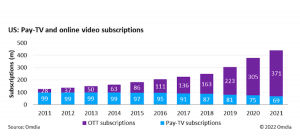
After more than 35 years of operation, TBI is closing its doors and our website will no longer be updated daily. Thank you for all of your support.
TBI Tech & Analysis: Getting behind the headlines on viewing habits
Netflix CEO Reed Hastings’ recent prediction around the demise of linear TV prompted a flurry of debate, but what are the facts? TBI delves into the annual Cross-Platform Viewing Time Report from research powerhouse Omdia to split fact from fiction.
The way we watch TV has been changing for years, but the recent comments from Netflix CEO Reed Hastings around linear TV’s imminent demise prompted heated discussion from various parties, most of whom – like Hastings – have a vested interest one way or another.
So how do things stand right now and what do we actually know? Well, quite a lot. Omdia, the research arm of TBI owner Informa, has delved into the changing consumption habits of viewers and the result is its newly released Cross-Platform Viewing Time Report for 2022.
Stand-out findings
Over the next couple of weeks, TBI Tech & Analysis will be dipping into the extensive report to bring you a selection of findings from around the world. But before we do, some stand-out results.
First up, the average total daily viewing time for the markets analysed (US, Australia, UK, France, Germany, Italy, Spain, Sweden and the Netherlands) stood at 362 minutes ((6 hours and 2 minutes) per person per day in 2021.
When excluding social media video viewing, this total stood at 303 minutes (5 hours and 3 minutes) with viewing time down by 10 minutes on the previous year.
More than that, linear TV viewing time decreased in all markets in 2021, with the ending of restrictions and lockdowns that marked most of 2020 being the primary cause but the continual shift toward on-demand viewing also driving this. In terms of overall minutes, Spain and Italy saw the largest fall in linear viewing, with both countries witnessing greater consumer moves towards OTT over the year.
American evolution
This week, we shall zoom in on select findings from the US, where cross-platform television viewing time fell by 1.3% in 2021 to 346.6 minutes per person, per day.
A further 79.8 minutes per person per day was spent watching video content via social media platforms, taking the total time spent to 418.4 minutes (6 hours and 58.4 minutes).
The results mean that linear viewing has been in decline for a decade now in the US, with live TV viewing moving from 277.3 in 2011 to 175.3 minutes in 2021, losing 102 minutes in total. Its share of total viewing has likewise fallen dramatically, with linear now registering just a 50.6% share of total TV viewing time, making 2021 the last year where linear will be ahead of nonlinear viewing in America.
 Time-shifted viewing also continued to fall during the year, with the continual declines in pay-TV subscriptions driving both linear and TSV viewing down for another consecutive year.
Time-shifted viewing also continued to fall during the year, with the continual declines in pay-TV subscriptions driving both linear and TSV viewing down for another consecutive year.
Time to move
Online long-form remains the most popular viewing platform for non-linear viewing time in 2020, increasing by 18.7% to reach 105.9 minutes. Subscriber growth from major new D2C players HBO Max (+6.9 million subs) and Peacock (+6.1 million subs) and growth from established players such as Netflix and Disney+ have driven much of this uptake in long form consumption.
Indeed, the launch of several new OTT over the last five years and the subsequent growth that has come from this have consequently pushed consumption rates even higher than 2020. Pay-TV VOD viewing time, in contrast, fell by 17.1% in 2021, with viewing falling into a similar pattern witnessed prior to the COVID-19 pandemic.
Online short-form viewing also witnessed a decline in viewing time in 2021, with consumption down by 7.2% to reach 24.5 minutes per person.
Despite this, YouTube viewing still plays a prominent role in overall VOD usage in the US, with 74.3% of monthly US users across all age groups using the video sharing platform in 2021, according to Omdia’s Consumer Surveys; with younger age groups (18–24 and 25–35) registering even higher usage, with 88% and 81.6% a piece, putting it in good stead for future growth.
Alongside the launch of its short form platform, YouTube Shorts, in September 2020, YouTube has also turned its focus toward connected TV, with the company rolling out a new feature in June 2022 that lets viewers use their phones to engage with the content they’re watching on their TV. YouTube’s parent company, Google, has been quite keen on positioning YouTube as a connected TV app as it can lead to huge viewership numbers outside of mobile.
After this, YouTube plans to test new designs to let connected-TV viewers access more features—such as browsing and shopping for products featured in videos—from their smartphones.
The extract above is from Cross-Platform Television Viewing Time Report – 2022, written by Omdia analysts Rob Moyser, Ajay Paul and Adam Thomas. To find out more, click here.




